Standard sizes
Choosing the right size of a bed for a child depends not only on the quality of sleep, but also on the harmonious growth and development of the baby. Below I have grouped different types of cribs by age groups. For each type, I will tell you the features of the choice and provide standard sizes. And if you want to find a quick answer without details, then go straight to the summary table.
For newborns (up to 3 years)
This age period is the most important in the development of the baby and here special attention should be paid to comfort and safety. After all, it is at this age that children spend most of their time in bed.
Let’s consider the most popular types of cribs and their features. When writing the article, I was guided primarily by GOST, and also studied what modern manufacturers offer.
In short, most often parents choose the following sizes:
- Length: 110-120 cm;
- Width: 60 cm;
- Height from the floor: 95 cm.
Check out our article on choosing a crib for a newborn.
Cocoon
It cannot be called a full-fledged crib, the cocoon is more like a children’s mattress, which can already be placed on a standard bed. But many parents are now buying this new product.
Length x Width x Height = 69 cm x 40 cm x 15-19 cm.
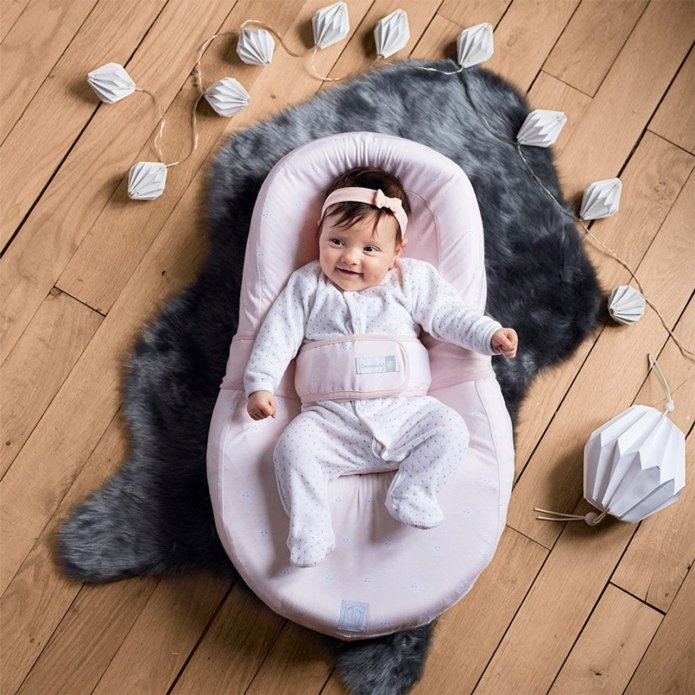
Cradle
A newborn baby must have a separate bed. Up to 6 months old, a newborn can sleep in a cradle – a bed that resembles a baby carriage. Psychologists claim that newborns behave more calmly and sleep better if they are surrounded on all sides by soft fabric – a kind of cocoon is created in which they feel protected, as in the mother’s womb.
The sleeping place in the cradle for a newborn is about 80×40 cm in size, minor deviations are possible. The design can be different, providing for the possibility of rocking or stationary, the support – on wheels or suspended. Transformer models are also produced, which can be adapted for various purposes. Often, cradles for newborns are supplied with additional devices – lighting, musical mobiles and mounts for children’s toys.
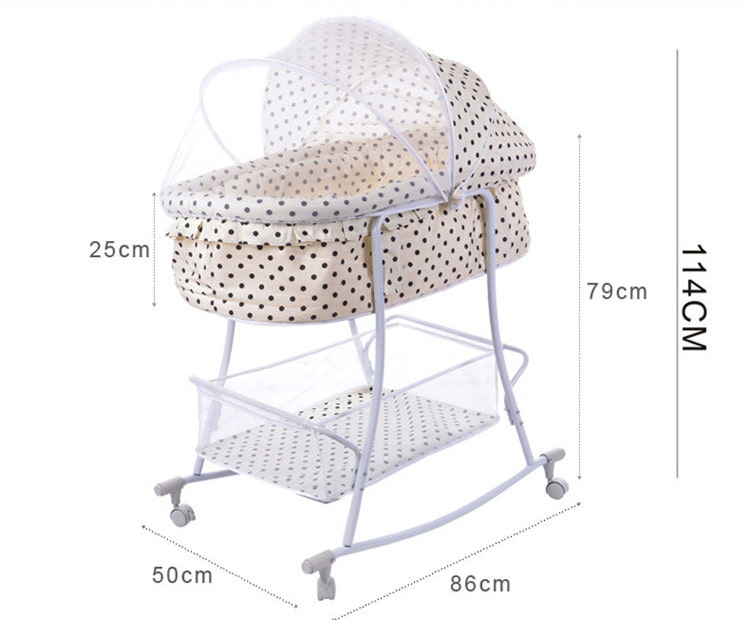

Pendulum cot
Slightly larger than cradles – length 120 cm, width 60-70 cm. The main feature of such a cot is the rocking mechanism and folding doors – this makes it easier to put the baby to bed and pick him up. You can also put a cocoon in it for the first months, and then use it for the baby itself.
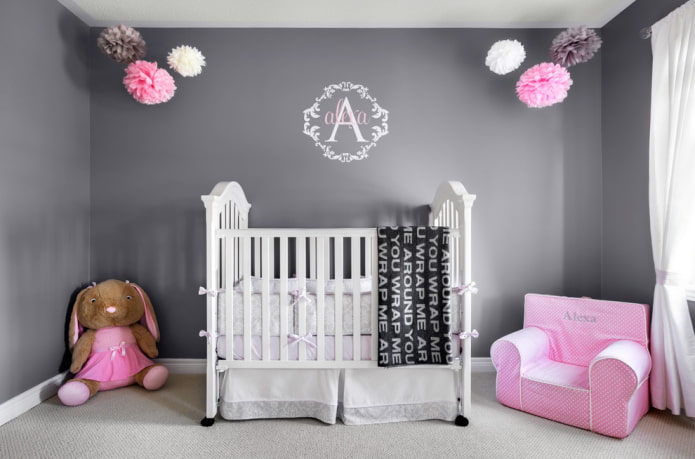
Additional cribs
The main difference is that the crib can be placed close to the parent’s bed. It is important to select the height to match yours, so take the appropriate measurements before going to the store. The size range varies:
- Length: 90-100 cm;
- Width: 50-60 cm;
- Height is adjustable.

Standard bed for newborns
The child grows quickly, so, as a rule, the bedding for him is bought “for growth”. At an early age, quite specific requirements are imposed on it – it is necessary that the baby’s bed have sides so that the newborn does not fall. After six months, the first cradle is usually replaced with a crib in which the sleeping area is surrounded by bars that protect the child from falling. In such a crib, he will be able to get up without the risk of ending up on the floor.
A standard sleeping area is 120×60 cm, external dimensions may vary depending on the model. It is good if the side walls are removable – this will make it easier to care for the newborn. It is also useful to be able to change the height of the base under the mattress – as the baby grows, it can be lowered. The dimensions of a baby crib from 3 to 5 years old can be larger, but, as a rule, this is not necessary.
Tip: Babies love to jump inside, holding on to the railings, that is, the crib simultaneously functions as a playpen. Pay attention to the base under the mattress: it should be strong, slatted – a solid plywood sheet will not support an active child.
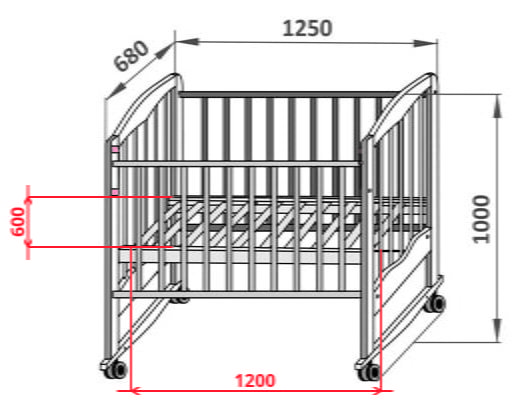

For a preschooler (from 3 to 5 years old)
When the baby becomes a preschooler, the requirements for dimensions change. Fencing slats are no longer needed, but there is a desire to sit on the bed during the day, play on it. Therefore, for children over 3 years old, the size of the bed becomes larger, and its design changes.
The width of children’s beds usually reaches 70 cm, and the length can vary from 130 to 160 cm.
There are also pull-out models that “grow” with the child. Until adolescence, that is, until ten to eleven years old, such a bed will be enough for the child. For restless children who toss and turn in their sleep, “spread out”, and sometimes lie down across, it is recommended to choose a slightly larger width – for example, 80 cm.
If we consider different types of beds, there are also non-standard models, for example, in the shape of a car. But only the visual part is non-standard there, and the dimensions usually correspond to the standards. Read about bunk beds and transformers in a separate section of this article.
Advice: The best material for children’s furniture is dense wood: beech, oak, hornbeam. It does not leave splinters when touched and is the safest for the child.
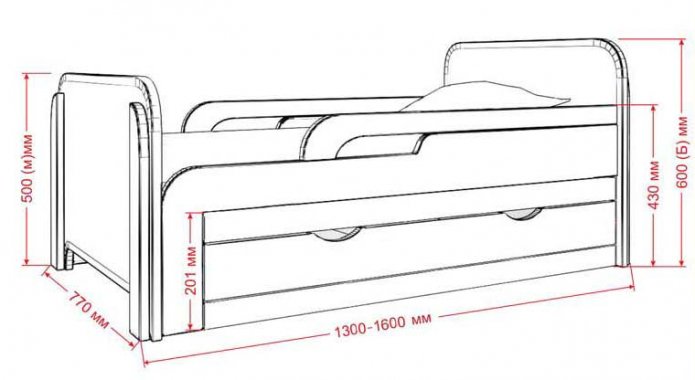
For schoolchildren and teenagers (from 5 years)
After 11 years, the child enters adolescence. The style and rhythm of his life changes, guests come to his room more often, more space is needed for studying and active activities. The teenage standard is considered to be the size of 180×90 cm, which is more similar to a full-fledged adult model than to a children’s one. Therefore, many parents do not see the point in buying such a bed – it will probably become too small in a couple of years, and you will have to buy a new one.
Therefore, the optimal size of a teenage bed can be taken as 200×90 cm, a full-fledged “adult” sleeping place will not only be more comfortable, but will also last longer. At this age, parents make the choice of design and shape together with teenagers, following their requests. You just need to make sure that the materials it is made of are environmentally friendly, and that the parts do not have sharp corners that can cause injury.
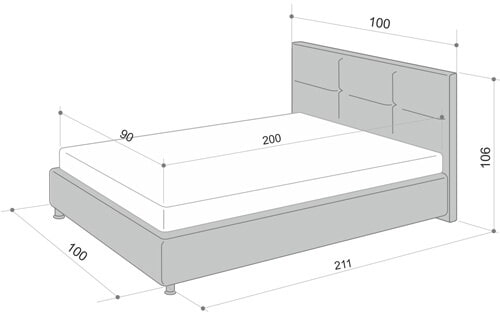

As for compatibility with different types of beds, standard models already have the dimensions of an adult single bed and have the following length and width: 180-200 cm by 80 cm respectively. Read about transformers and bunk beds below in the relevant sections, as they can be suitable for several age groups at once.
Dimensions for a loft bed
This type is best used for older children, as the sleeping area is located on the second tier, which is unsafe for small children. A loft bed will allow you to place an entire children’s room in a small area with a place for games, study, a storage system for clothes, toys and books, as well as a night’s rest. The table, wardrobe and shelves in a bunk bed are located on the “first” floor, the sleeping area is above them.
The dimensions are selected individually, as such furniture is usually made to order. The most popular dimensions of the sleeping area are 200 cm x 100 cm. But there are recommendations for height – take into account the height of the child with a margin of 20-30 cm. Also, for safety, I would recommend using sides at least 35 cm high.
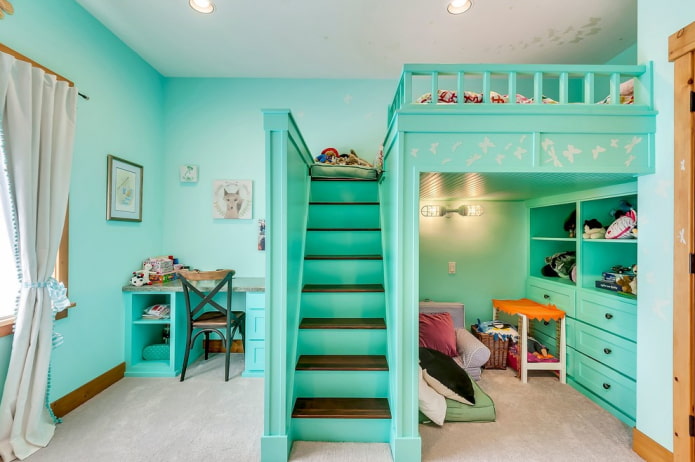
Dimensions of a bunk bed
When there are two children in the house, and they have one room, the issue of saving space arises. Consider buying a bunk bed – it will not only free up space in the children’s room for games, but will also serve as a kind of exercise machine, as well as a place for games. Usually two sleeping places are located one above the other, sometimes with a shift relative to each other.
The child climbs to the “second floor” using a special ladder – it can be very simple, reminiscent of a “Swedish” wall, or more complex, with wide steps, under which there can be boxes for children’s toys.
The size of the bunk bed is affected by its shape and the presence of additional elements – shelves, drawers, storage sections. In addition, some models have built-in small tables where schoolchildren can do their homework, and younger children can draw, assemble a construction set, or do modeling.
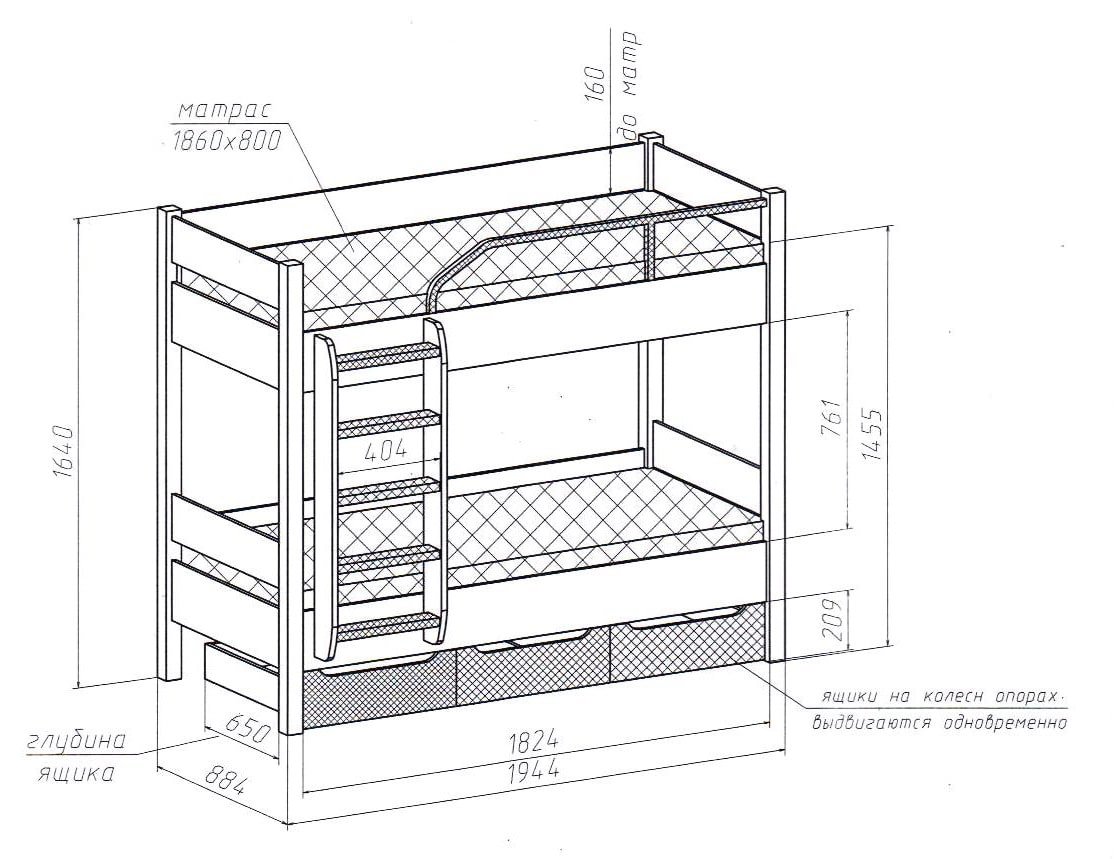

The height of the structure is determined by the height of the ceiling – there should be enough space above the head of the child sitting on it so that he does not feel uncomfortable. Usually, the standard height of a 2-tier children’s bed ranges from 1.5 to 1.8 m. You need to choose a specific model based on the height of the ceilings in the children’s room.
The external dimensions of a 2-tier model can vary quite a lot and depend on the model, for example, 210 cm wide, 180 cm high, and 100 cm long. At the same time, the sleeping area usually has a standard size of 200×80 or 200×90 cm. Sometimes such beds are combined with work places – this is a good option for a family with two schoolchildren. In some cases, it is advisable to arrange a bed on the “second floor” for one child.
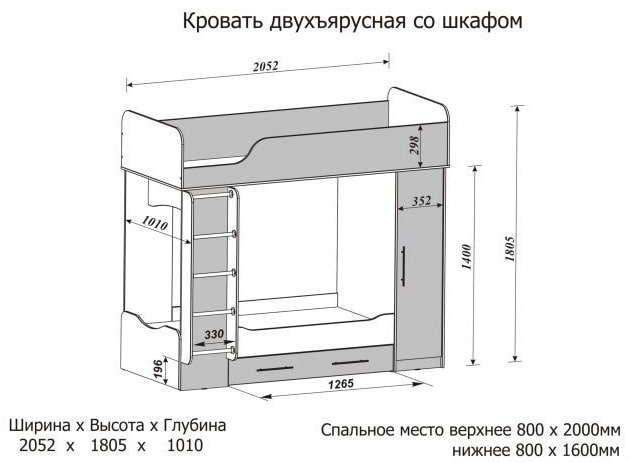

Transformer bed sizes
Changing a child’s bed for a new one every two or three years is quite expensive. A transforming bed changes and grows with the child. It is quite difficult to call it a bed – after all, over time, from a baby cradle for a newborn, equipped with a pendulum swing mechanism, combined with drawers and cabinets for diapers, baby care products and other necessary things, this furniture turns into a free-standing bed for a teenager and a desk with a convenient nightstand.
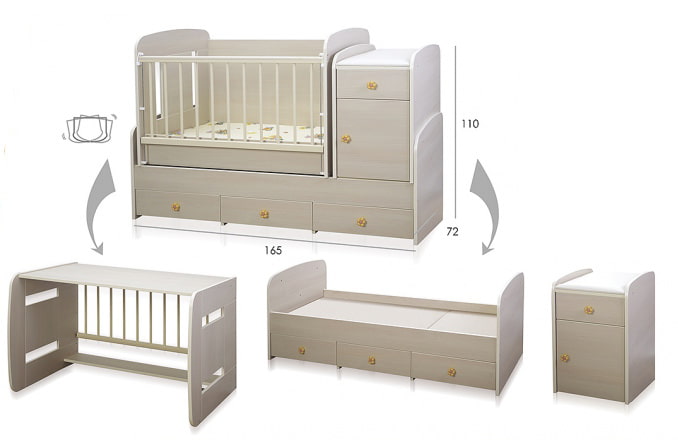

Summary table
Recommendations for choosing mattresses
Requirements to mattresses vary greatly depending on the age of the child. From birth to two years, the baby’s back needs support – at this time, the skeletal system is very flexible, and the muscular skeleton is just forming, so the mattress should be hard and elastic. Then you can put the child on a medium-hard mattress. But soft ones should be avoided until the formation of the musculoskeletal system is complete, that is, latex, latexed coconut coir and their combinations.
Standard mattress sizes for children’s cots, as a rule, coincide with the standard sizes of beds, but they can also differ, so the mattress is bought either at the same time as the crib, or after purchasing the latter and careful measurements.
Standard mattress sizes for children’s and single beds
The main thing to remember is to focus on the age and height of the child, but of course the layout of the room. And also never forget about the safety and comfort of the baby! Choose solid, ergonomic models from reliable manufacturers. Otherwise, complete freedom of creativity!